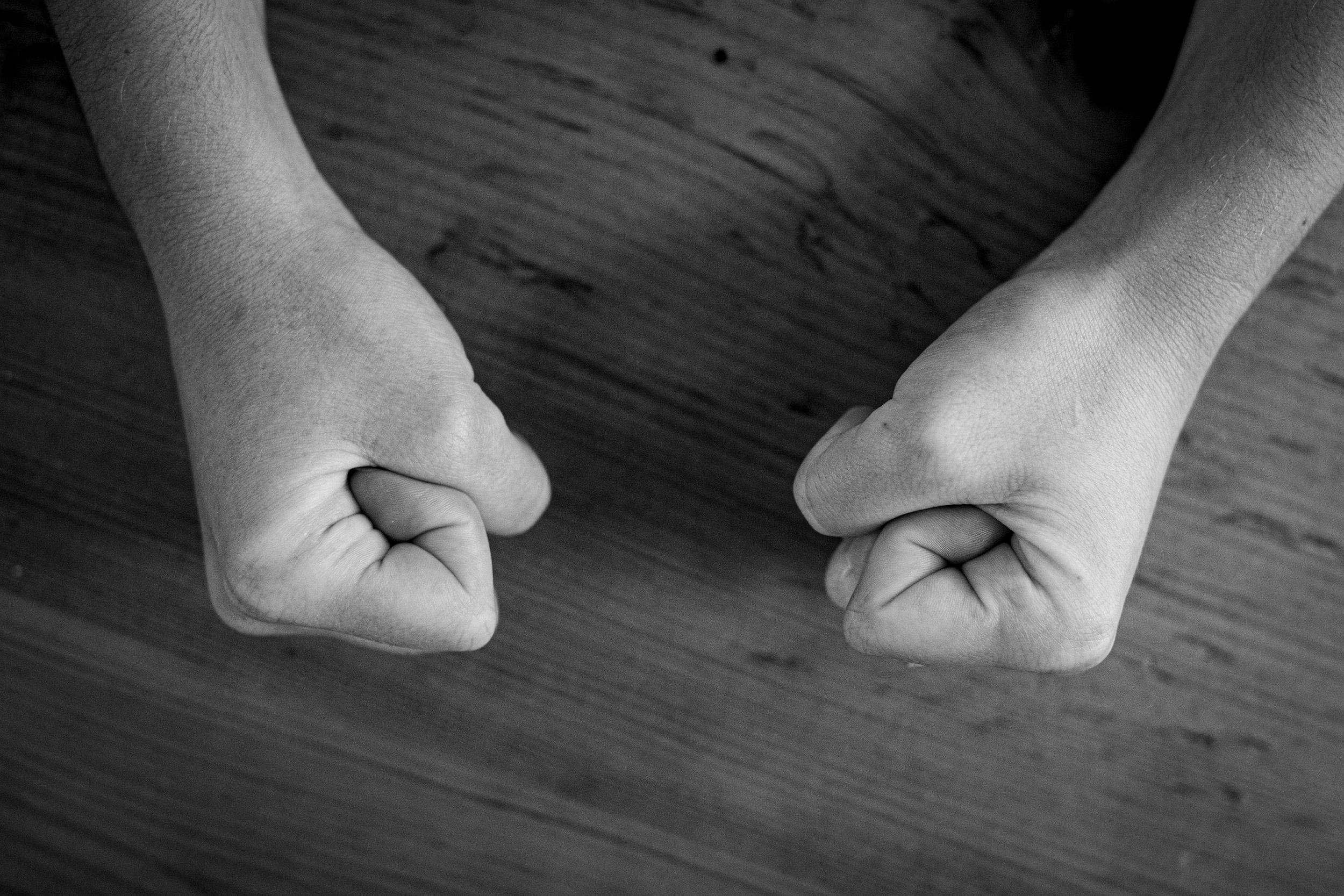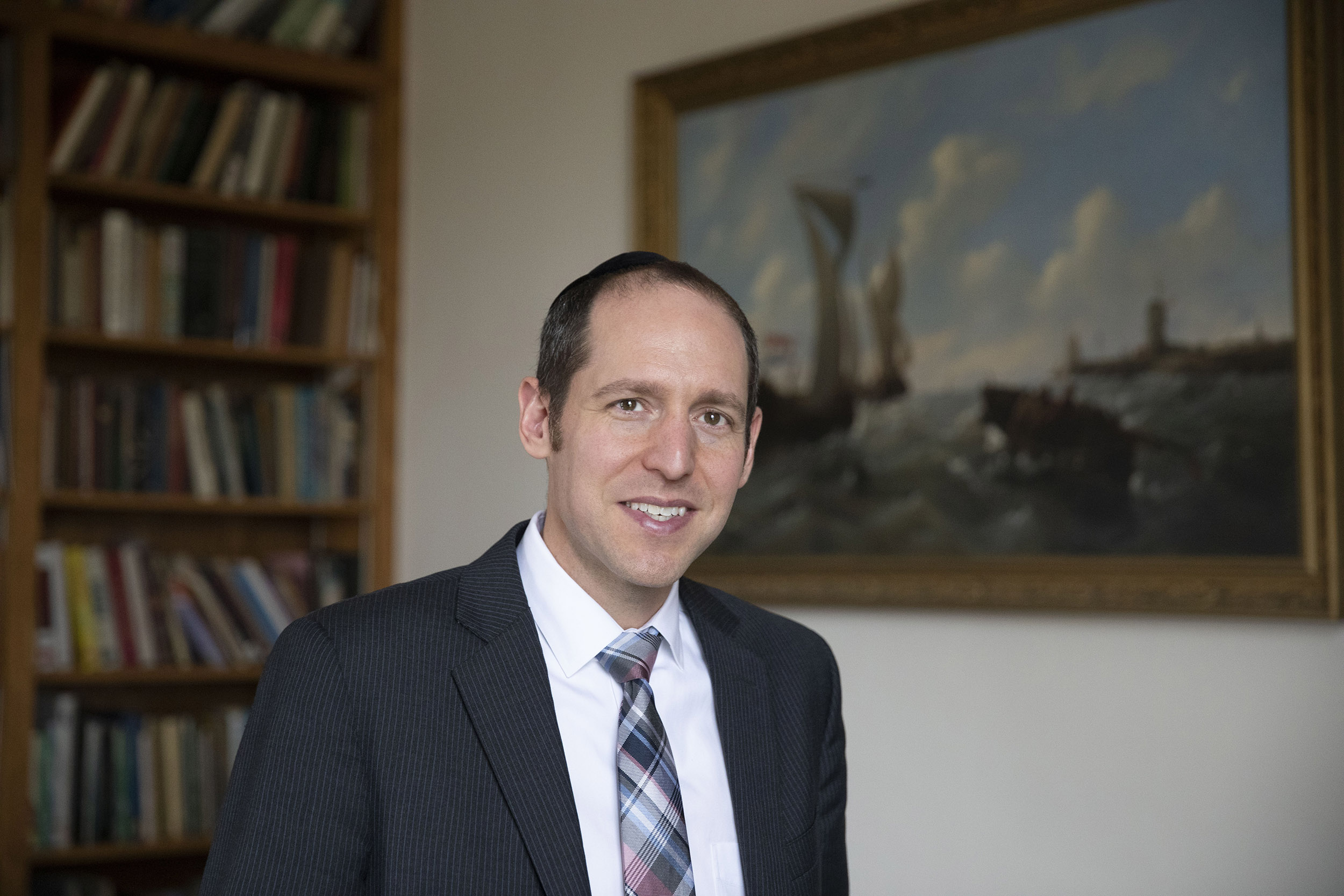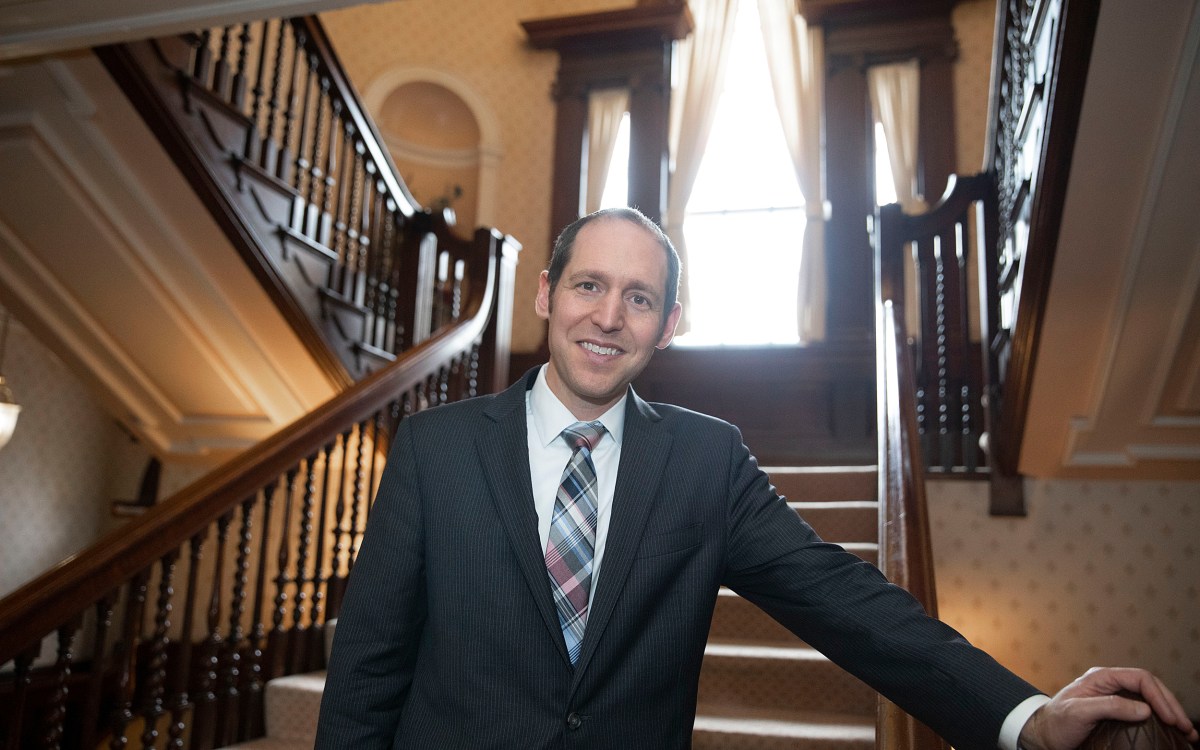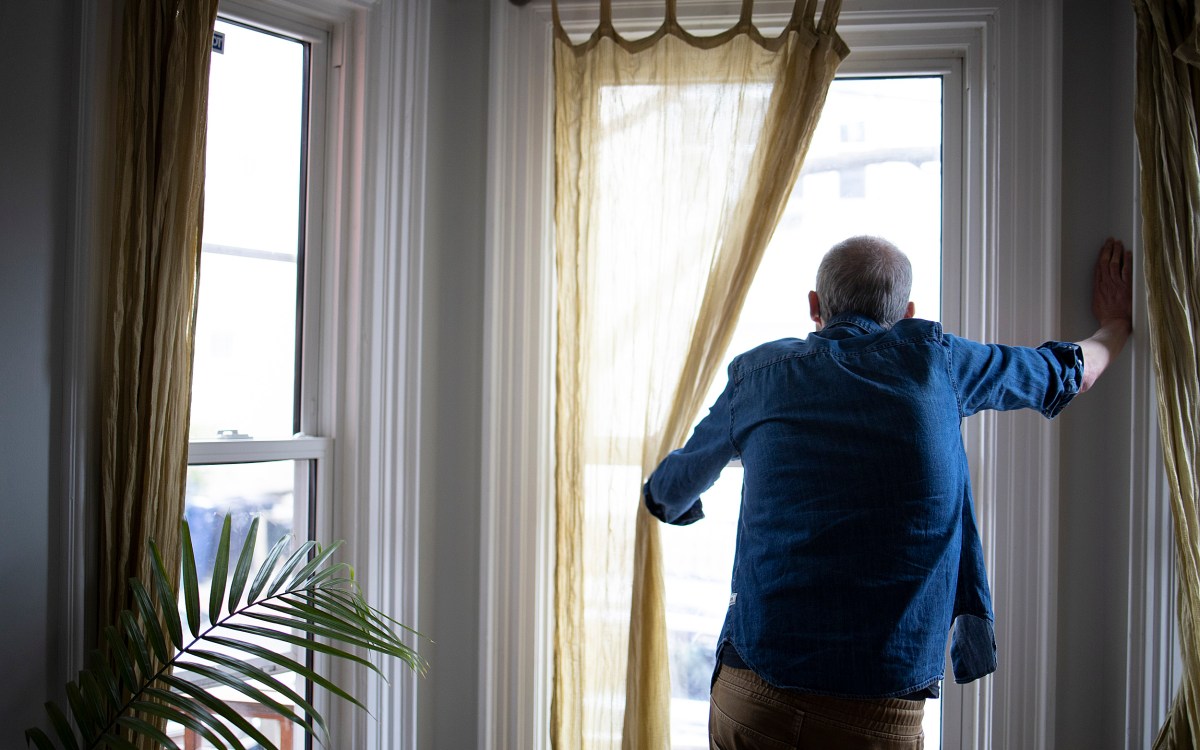
Rose Lincoln/Harvard Staff Photographer
Soothing advice for mad America
McLean’s Rosmarin offers perspective on the pandemic’s raging effects
Tensions are high about many things right now in America, and health and safety concerns over the COVID-19 virus rank high among them, particularly in families. Many parents are fearful about in-person classes for their children; others are upset that classes will remain remote. Neighbors are irritated by those not abiding by the latest public health guidelines, and by those who are. Some workers can’t wait to return to their offices; others resent being forced to. No one wants to get sick or lose their job.
David H. Rosmarin has seen and heard it all. The assistant professor of psychology in Harvard Medical School’s Department of Psychiatry is a clinician at McLean Hospital. He runs the hospital’s Spirituality and Mental Health program and has observed rising levels of anger — and its expression in aggression and domestic abuse — in his practice. Rosmarin spoke with the Gazette about the pandemic-fueled ire afoot in America today and what counsel he would offer us all.
Q&A
David H. Rosmarin
GAZETTE: It doesn’t take heightened perception to see a lot of anger abroad in the country. There’s anger around masks; parents are angry; teachers are angry. There were protests against the shutdowns, then the George Floyd protests, and continued protests today. Let’s start with your observations. Do you agree that there seems to be more anger in the country and is it showing up in your practice?
ROSMARIN: There’s no question. Tension is heightened today, and anger is definitely part of that, maybe even an artifact of that. People are definitely exhibiting more anger. Incidents of domestic violence seem to be increasing, which is the most concerning. Personally, I was on a run the other day and somebody yelled at me for wearing a mask, in Boston. So, I looked into it, and they’re actually right. I’m running around a reservoir; I’m away from everybody. So the next day, I think, “Maybe I won’t wear my mask today.” Then I approached a lady, I’m 20 feet away, and I smiled at her and she angrily yelled, “Don’t smile at me. You’re not wearing a mask. You’re taking a chance with my life!” So you can’t win. That was the conclusion I came to.
GAZETTE: What are you seeing in your practice?
ROSMARIN: We’re definitely seeing tensions heightened in families: domestic violence, domestic abuse. There’s some indication of child mistreatment increasing. People are more on edge and one of the ways that they express that is through anger, which obviously is not healthy.
GAZETTE: I don’t know if being mad is officially a condition. Are there conditions that manifest as anger?
ROSMARIN: Anger actually does come up in the clinical literature. One is “intermittent explosive disorder”: repeated, sudden episodes of impulsive, angry, violent behavior. But that’s not a common diagnosis, and it’s not usually the kind of thing that people come in for. The other place you find it is in bipolar disorder. The most common presentation of bipolar is where people are hyper, high, excited, or elated. It’s not as common, but it does happen that the primary symptom of mania is being irate, angry — an out-of-control anger — starting fights with strangers, a level of anger that’s really disconnected from the reality of the situation.
“Take the mask example. The real core of someone telling another to put on a mask is fear.”
GAZETTE: I read that both anxiety and depression can manifest as anger. Is that accurate?
ROSMARIN: Yes, very much so, and I don’t think that the clinical literature captures what’s going on here. One of the ways of thinking about anger — which I find helpful from a clinical standpoint — is to conceptualize it as a secondary emotion. Fear, anger, joy, and sadness are your four primary emotions, and secondary emotions occur as a reaction to our primary emotions, rather than to the situation. If I called you up and said, “Hey, I have a million-dollar check for you to come pick up,” you’ll have a joy reaction — and maybe some fear — but an automatic emotional reaction. But with anger, it is usually a secondary reaction. I feel sad or I feel anxious and I don’t like that feeling, so I get angry at the person. [In other words, although anger is classified as a primary emotion, it’s often expressed in secondary ways.}

Take the mask example. The real core of someone telling another to put on a mask is fear. “I don’t want to die or for someone I know who is high risk to die.” “I want the coronavirus to go away.” “I don’t want my stress level to be so high.” “I want this virus to be contained.” “I want this nightmare to be over.”
There’s fear; there’s sadness. But we skip over that. I’m feeling sad or anxious, but instead of dealing with those emotions, draw a gun or yell at someone or at least make fun of them.
GAZETTE: But the mask example cuts both ways. You have fear of getting COVID, but then there’s the person drawing a gun in a Walmart over someone telling him to put on a mask, which presumably protects from COVID. Is that fear or something else?
ROSMARIN: I would explain that situation as somebody afraid of their civil liberties being taken away. They’re really deathly afraid of it. “I’m an American, and I don’t want government to tell me what to do.” “That’s not my country, and that makes me really afraid to think that a bunch of liberals are taking over.” That’s a visceral fear but instead of expressing it directly — “Hey, I really don’t feel comfortable with masks. I don’t see the rationale and this is a free country” — the expression instead is, “Get out of my face right now!” That’s anger, the reaction to the reaction.
GAZETTE: How might that apply to schools and reopening plans? I’ve heard of parents lashing out at school boards — one woman threatened to follow teachers to see whether they’re working if schools aren’t reopened fully. Teachers are frustrated over reopening plans. Is that about fear for the kids?
ROSMARIN: I would imagine that the woman is deathly afraid of what’s going to happen when her kids don’t go to school, but she’s expressing anger because it’s more comfortable — although more dysfunctional — to say, “Get this problem fixed,” as opposed to, “I really don’t think I can handle another year of Zoom school. Things being unclear is just driving me insane. Can you please help me?”
GAZETTE: Is it possible that some of the anger is just misplaced? That people are really mad at the virus and its impacts, but expressing it as anger at the people charged with making decisions about society’s response to it? Kind of a shoot-the-messenger thing?
ROSMARIN: That’s one way to think about it, but even then I think the anger toward the virus is because we’re really afraid of it. This comes from attachment theory, which basically says that all human beings need to have connection with others, but we go into anger or attack mode as a way of defending ourselves. When we’re aggressive, we don’t have to show vulnerability to other people. If the woman who’s angry at the school board were to say, “Hey, I really can’t hack this. I can’t handle it,” she’d actually be showing the school board that they have power over her by showing her vulnerability. That’s too scary to do, so she gets angry.
GAZETTE: So anger is way to express that same thing, but still seem strong to others?
ROSMARIN: Yes, that’s it. We’re trying — she’s trying — to show, “I don’t need you; you need me. And I’m going to make your life miserable unless you do what I want.” The net effect, obviously, is that people want to do what she says even less. She’s less likely to get what she wants because now she’s ruptured the relationship. So it’s lose-lose.
“When we’re aggressive, we don’t have to show vulnerability to other people.”
GAZETTE: If folks reading this article become reflective and perhaps recognize some of these emotions in themselves, how would you recommend dealing with it?
ROSMARIN: That’s a great question. It’s hard, but clinically I recommend that people first acknowledge their vulnerability to others in their lives. The reality is that we do need other people. An example is, if you take adult romantic partners who are fighting with each other, there’s a common pattern in which one person, instead of saying “I need you,” will get angry at the other person. Then the other person will withdraw. Then the first person will get even more angry, and the other will withdraw more. In attachment theory, this problematic pattern is called pursue-withdraw, and it’s very, very common.
GAZETTE: How do you break out of it?
ROSMARIN: The best clinical approach I’ve seen for this is called Emotionally Focused Therapy, or EFT. In EFT, we teach the pursuer — the aggressor — to express a sense of needing or longing for the withdrawer. Why is the withdrawer moving back as opposed to moving forward? It’s because they’re scared out of their mind that they’re going to be torn to shreds and hurt by the aggression. It’s very hard to stop that withdrawal pattern in the context of anger. So, we help the pursuer to acknowledge to themselves and to their partner, “I need you. When you don’t call me, it makes me wonder whether you care about me and that makes me feel alone,” instead of saying, “Why don’t you call me, you jerk?!”
Anger puts the responsibility on the other person: “You’re not coming through for me.” “You need to get the schools together.” “You need to back off and stop telling me to wear a mask.” “You need to call me more.” As opposed to the language of attachment: “I need you to give me my space.” “I need you to help me because I can’t handle the uncertainty of the school year.” “I need you to call me more because I feel really alone and that’s just a really nasty place for me to go and I hate it.”
GAZETTE: Is this fix pretty straightforward once people get it, or is it hard to do?
ROSMARIN: Straightforward in theory, but like anything worthwhile in life, it’s hard to do. People get back into pursue-withdraw patterns very easily and they’re often well-trodden. EFT is a monthslong process, not weeks. On the bright side, it’s not rocket science. The first step is simply to recognize, “Why am I getting angry? Oh, there are primary emotions beneath that. OK. What are those primary emotions? Can I acknowledge those to myself and can I express that to this other person?”
I also study spirituality and mental health. And one piece that’s relevant here is that spirituality can help us to acknowledge that fallibility and uncertainty are just part of being human. Being all-mighty or all-knowing, those are not human traits from diverse spiritual perspectives. There is data that spirituality can be protective when it comes to anger, and that could be because it helps us to be comfortable feeling vulnerable and expressing that vulnerability. Spirituality can help us to lean on others as opposed to having to show our prowess.
GAZETTE: So, in our current context, how should people think about this? Is COVID part of the formula for an angry person or a couple who’s fighting?
ROSMARIN: I think it’s part of the context. For example, let’s say you’re walking down the street and somebody’s not wearing a mask. You say to them, “Hey, I noticed you’re not wearing a mask. Don’t worry. I’m not angry. I’m not gonna yell at you. But I want to let you know that I’m high risk, or I live with someone who’s high risk, or it makes me really anxious and would you mind putting on a mask?” That’s a very different message, than …
GAZETTE: … you jerk.
ROSMARIN: Very different. And it gets a different response. The reality is that we can’t really control the other person or whether they’re going to wear a mask. But we’re going to maximize the likelihood of their compliance by showing our vulnerability, ironically. When we show anger, we’re communicating, “I’m strong, I can do whatever …,” but we actually show our weakness, because at the end of the day they don’t need to listen.
GAZETTE: And in the face of this virus, we’re all really weak.
ROSMARIN: We are. And we grow in our emotional strength when we admit and acknowledge that weakness. We are uncertain about the future, and that’s okay. We don’t have to have all the knowledge, or strength. When we can accept and express it to the people around us we increase the chances of getting their love and support, and we can thrive even in this challenging time. As attachment theory teaches us, what we really need is not to be strong, but to be close and connected to the people around us.
Interview was edited for clarity and trimmed for length.









